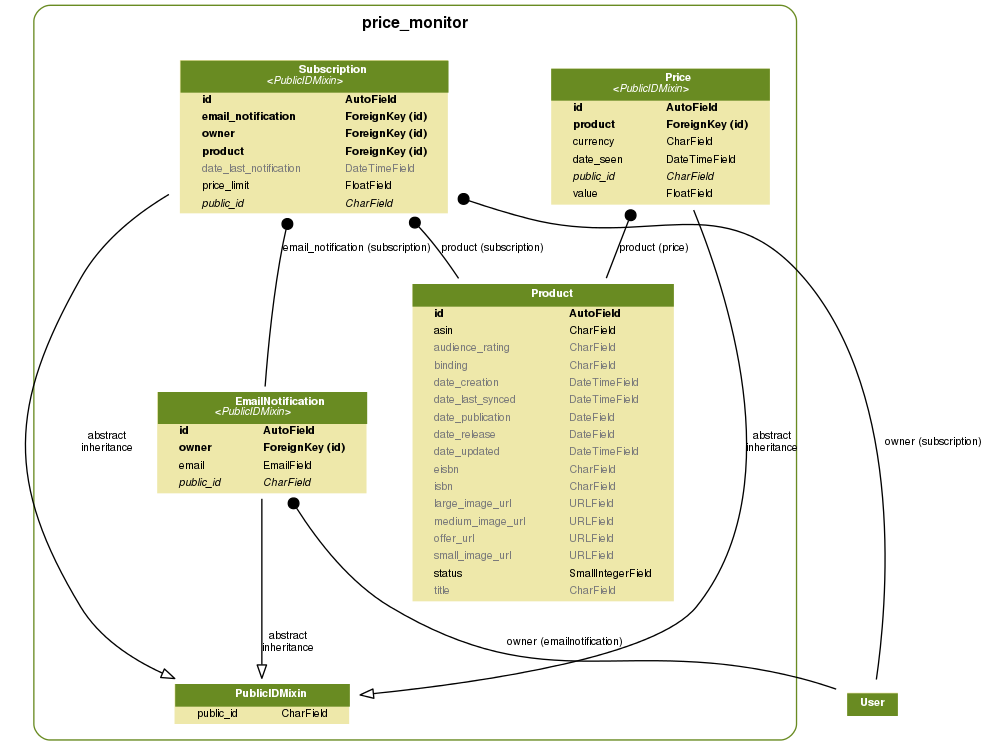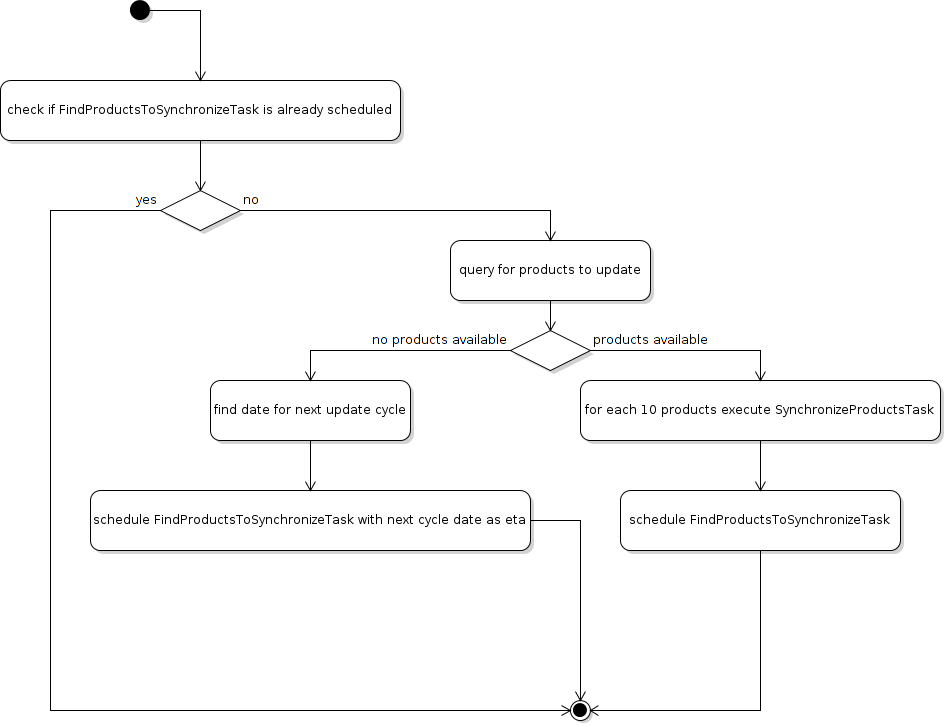Monitors prices of Amazon products via Product Advertising API
Project description
django-amazon-price-monitor
Monitors prices of Amazon products via Product Advertising API.
Basic structure
This is a reusable Django app that can be plugged into your project. It consists basically of this parts:
Models
Frontend components
Angular Frontend API
Amazon API component
Models
Product
representation of an Amazon product
Price
representation of a price of an Amazon product at a specific time
Subscription
subscribe to a product at a specific price with an email notification
Frontend components
The frontend displays all subscribed products with additional information and some graphs for price history.
The features are the following:
list products
show product details
show product price graphs
add subscriptions
adjust subscription price value
delete subscriptions
Angular Frontend API
Simply the API consumed by AngularJS, based on Django REST Framework.
Amazon API component
Fetches product information from Amazon Product Advertising API through several tasks powered by Celery and weaves the data into the models.
License
This software is licensed with the MIT license. So feel free to do with it whatever you like.
Setup
Prerequisites
Python |
3.3 |
3.4 |
3.5 |
|---|---|---|---|
Django |
1.8 |
1.8 or 1.9 |
1.9 |
For additional used packages see setup.py.
Included angular libraries
angular-django-rest-resource (commit: 81d752b363668d674201c09d7a2ce6f418a44f13)
Basic setup
Add the following apps to INSTALLED_APPS:
INSTALLED_APPS = (
...
'price_monitor',
'price_monitor.product_advertising_api',
'rest_framework',
)
Then migrate:
python manage.py migrate
Adjust the settings appropiately, see next chapter.
Include the url configuration.
Setup celery - you’ll need the beat and a worker.
Settings
The values of the following displayed settings are their default values. If the value is ‘…’ then there is no default value.
Must have settings
The following settings are absolutely necessary to the price monitor running, please set them:
Celery
You need to have a broker and a result backend set.
BROKER_URL = ... CELERY_RESULT_BACKEND = ... # some additional settings CELERY_ACCEPT_CONTENT = ['pickle', 'json'] CELERY_CHORD_PROPAGATES = True
Rest-Framework
We use Rest-Framework for Angular frontend:
REST_FRAMEWORK = {
'PAGINATE_BY': 50,
'PAGINATE_BY_PARAM': 'page_size',
'MAX_PAGINATE_BY': 100,
}
Site URL
Specify the base URL under which your site will be available. Defaults to: http://localhost:8000 Necessary for creating links to the site within the notification emails.
# base url to the site PRICE_MONITOR_BASE_URL = 'https://....'
AWS and Product Advertising API credentials
# your Amazon Web Services access key id PRICE_MONITOR_AWS_ACCESS_KEY_ID = '...' # your Amazon Web Services secret access key PRICE_MONITOR_AWS_SECRET_ACCESS_KEY = '...' # the region endpoint you want to use. # Typically the country you'll run the price monitor in. # possible values: CA, CN, DE, ES, FR, IT, JP, UK, US PRICE_MONITOR_AMAZON_PRODUCT_API_REGION = '...' # the assoc tag of the Amazon Product Advertising API PRICE_MONITOR_AMAZON_PRODUCT_API_ASSOC_TAG = '...'
Amazon associates
As the links to Amazon will be affiliate links with your Amazon associate tag (see above), you have to set your name for the disclaimer (see https://partnernet.amazon.de/gp/associates/agreement).
# name of you/your site
PRICE_MONITOR_AMAZON_ASSOCIATE_NAME = 'name/sitename'
# Amazon site being used, choose from on of the following
'Amazon.co.uk'
'Local.Amazon.co.uk'
'Amazon.de'
'de.BuyVIP.com'
'Amazon.fr'
'Amazon.it'
'it.BuyVIP.com'
'Amazon.es'
'es.BuyVIP.com'
PRICE_MONITOR_AMAZON_ASSOCIATE_SITE = '<ONE FROM ABOVE>'
Images protocol and domain
# if to use the HTTPS URLs for Amazon images. # if you're running the monitor on SSL, set this to True # INFO: # Product images are served directly from Amazon. # This is a restriction when using the Amazon Product Advertising API PRICE_MONITOR_IMAGES_USE_SSL = True # domain to use for image serving. # typically analog to the api region following the URL pattern # https://images-<REGION>.ssl-images-amazon.com PRICE_MONITOR_AMAZON_SSL_IMAGE_DOMAIN = 'https://images-eu.ssl-images-amazon.com'
Optional settings
The following settings can be adjusted but come with reasonable default values.
Product synchronization
# time after which products shall be refreshed # Amazon only allows caching up to 24 hours, so the maximum value is 1440! PRICE_MONITOR_AMAZON_PRODUCT_REFRESH_THRESHOLD_MINUTES = 720 # 12 hours
Notifications
To be able to send out the notification emails, set up a proper email backend (see Django documentation).
# time after which to notify the user again about a price limit hit (in minutes)
PRICE_MONITOR_SUBSCRIPTION_RENOTIFICATION_MINUTES = 10080 # 7 days
# sender address of the notification email
PRICE_MONITOR_EMAIL_SENDER = 'noreply@localhost'
# currency name to use on notifications
PRICE_MONITOR_DEFAULT_CURRENCY = 'EUR'
# subject and body of the notification emails
gettext = lambda x: x
PRICE_MONITOR_I18N_EMAIL_NOTIFICATION_SUBJECT = gettext(
'Price limit for %(product)s reached'
)
PRICE_MONITOR_I18N_EMAIL_NOTIFICATION_BODY = gettext(
'The price limit of %(price_limit)0.2f %(currency)s has been reached for the '
'article "%(product_title)s" - the current price is %(price)0.2f %(currency)s.'
'\n\nPlease support our platform by using this '
'link for buying: %(link)s\n\n\nRegards,\nThe Team'
)
# name of the site in notifications
PRICE_MONITOR_SITENAME = 'Price Monitor'
Caching
# key of cache (according to project config) to use for graphs # None disables caching. PRICE_MONITOR_GRAPH_CACHE_NAME = None # prefix for cache key used for graphs PRICE_MONITOR_GRAPH_CACHE_KEY_PREFIX = 'graph_'
Celery settings
To be able to run the required Celery tasks, Celery itself has to be set up. Please see the Celery Documentation about how to setup the whole thing. You’ll need a broker and a result backend configured.
Development setup with Docker
The package comes with an easy to use Docker setup - you just need docker and docker-compose. The setup is nearly similar to the one of treasury ( a project by darignac), you can read the documentation there to get a better insight.
Structure
There are 5 containers:
db |
Postgres database |
redis |
Celery broker |
web |
a django project containing the django-amazon-price-monitor package |
celery |
the celery for the django project |
data |
container for mounted volumes |
The web and celery containers are using a docker image being set up under docker/web.
Image: base
Basic image with all necessary system packages and pre-installed lxml and psycopg2. The image can be found on Docker Hub.
Image: web
It comes with a Django project with login/logout view, that can be found under docker/web/project. The image derives from pricemonitor/base from above.
The directory structure within the container is the following (base dir: /srv/):
root:/srv tree ├── logs [log files] ├── media [media files] ├── project [the django project] ├── static [static files] └── pricemonitor [the pricemonitor package]
Starts via the start script docker/web/web_run.sh that does migrations and the starts the runserver.
Image: celery
Basically the same as web, but starts the Celery worker with beat.
If you want to develop anything involving tasks, see the Usage section below.
Image: data
The data container mounts several paths:
Folder in container |
Folder on host |
Information |
|---|---|---|
/var/lib/postgresql/data |
<PROJECTROOT>/docker/postgres |
|
/srv/logs |
<PROJECTROOT>/docker/logs |
Django logs (see project settings) |
/srv/media |
<PROJECTROOT>/docker/media |
Django media files |
/srv/project |
<PROJECTROOT>/docker/web/project |
|
/srv/pricemonitor |
<PROJECTROOT> |
|
Usage
Override settings
To override some settings as well as to set up the required AWS settings you can create a docker-compose.override.yml and fill with the specific values (also see docker-compose documentation).
Please see or adjust the docker\web\project\settings.py for all settings that are read from the environment. They can be overwritten.
A sample docker-compose.override.yml file could look like this:
version: '2'
services:
celery:
command: /bin/true
environment:
PRICE_MONITOR_AWS_ACCESS_KEY_ID: XXX
PRICE_MONITOR_AWS_SECRET_ACCESS_KEY: XXX
PRICE_MONITOR_AMAZON_PRODUCT_API_REGION: DE
PRICE_MONITOR_AMAZON_PRODUCT_API_ASSOC_TAG: XXX
PRICE_MONITOR_AMAZON_PRODUCT_REFRESH_THRESHOLD_MINUTES: 5
PRICE_MONITOR_SUBSCRIPTION_RENOTIFICATION_MINUTES: 60
It will avoid the automatic startup of celery (command: /bin/true) and set the required settings for AWS (in fact they are only needed in the celery container). You can then manually start the container and execute celery which is quite useful if you develop anything that includes changes in the tasks and thus requires the celery to be restarted (execute from the docker folder!):
alex@tyrion:~/projects/github/django-amazon-price-monitor/docker$ docker-compose run celery bash Starting docker_data_1 # check environment variables root@9d64bbd23e98:/srv/project# env HOSTNAME=9d64bbd23e98 EMAIL_BACKEND=django.core.mail.backends.filebased.EmailBackend POSTGRES_DB=pm_db TERM=xterm PYTHONUNBUFFERED=1 PRICE_MONITOR_SUBSCRIPTION_RENOTIFICATION_MINUTES=60 POSTGRES_PASSWORD=6i2vmzq5C6BuSf5k33A6tmMSHwKKv0Pu PATH=/usr/local/sbin:/usr/local/bin:/usr/sbin:/usr/bin:/sbin:/bin SECRET_KEY=Vceev7yWMtEQzHaTZX52 PWD=/srv/project BROKER_URL=redis://redis/1 C_FORCE_ROOT='True' PRICE_MONITOR_AWS_SECRET_ACCESS_KEY=XXX POSTGRES_USER=pm_user SHLVL=1 HOME=/root PRICE_MONITOR_AMAZON_PRODUCT_REFRESH_THRESHOLD_MINUTES=5 PRICE_MONITOR_AMAZON_PRODUCT_API_REGION=DE PRICE_MONITOR_AMAZON_PRODUCT_API_ASSOC_TAG=XXX DEBUG='True' PRICE_MONITOR_AWS_ACCESS_KEY_ID=XXX _=/usr/bin/env # start celery (worker and beat) (can also execute /srv/celery_run.sh) root@9d64bbd23e98:/srv/project# celery --beat -A glue worker -------------- celery@9d64bbd23e98 v3.1.23 (Cipater) ---- **** ----- --- * *** * -- Linux-3.16.0-4-amd64-x86_64-with-debian-8.0 -- * - **** --- - ** ---------- [config] - ** ---------- .> app: glue:0x7fc6b5269e10 - ** ---------- .> transport: redis://redis:6379/1 - ** ---------- .> results: disabled:// - *** --- * --- .> concurrency: 8 (prefork) -- ******* ---- --- ***** ----- [queues] -------------- .> celery exchange=celery(direct) key=celery [2016-03-20 10:02:26,776: WARNING/MainProcess] celery@9d64bbd23e98 ready.
Start/Stop/Build
Use the make file to execute the most common tasks. It will execute docker-compose with the project name pm resulting in the container’s name pattern pm_*.
docker-build-base: - builds the base docker image docker-build-web: - builds the web docker image docker-up: - uses docker-compose to bring the containers up docker-stop: - uses docker-compose to stop the containers docker-ps: - runs docker-compose ps
A fixture with a Django user admin and the password password is loaded automatically.
Templates
As the fronted is done by Angular, there is only a single template with very limited possibilities to adjust, price_monitor/angular_index_view.html. You can extends the template and adjust the following blocks.
Management Commands
price_monitor_batch_create_products
A management command to batch create a number of products by providing their ASIN:
python manage.py price_monitor_batch_create_products <ASIN1> <ASIN2> <ASIN3>
price_monitor_recreate_product
Recreates a product with the given asin. If product already exists, it is deleted. Only use in development!
python manage.py price_monitor_recreate_product <ASIN>
price_monitor_search
Searches for products at Amazon (not within the database) with the given ASINs and prints out their details.
python manage.py price_monitor_search <ASIN1> <ASIN2> ...
Loggers
price_monitor
The app uses the logger “price_monitor” to log all error and info messages that are not included within a dedicated other logger. Please see the Django logging documentation for how to setup loggers.
price_monitor.product_advertising_api
Logger for everything related to the ProductAdvertisingAPI wrapper class that accesses the Amazon Product Advertising API through bottlenose.
price_monitor.utils
Logger for the utils module.
Tests
Coverage
Internals
Model graph

Product advertising api synchronization
Task workflow

Image of Product advertising api synchronization workflow
Change Log
0.7
Features:
footer can now be extended through template block footer
removed urlpatterns to please Django 1.10 deprecation
added docker setup for development (PR#101)
list products with audience rating 18+ in notification mail if region is Germany and product is also 18+ #92 (PR#93)
Bugfixes:
0.6.1
Bugfixes:
0.6
Features:
Bugfixes:
0.5
Features:
Add link to PM frontend in notification email #76
Django 1.9 support (see pull request #80)
Bugfixes:
FindProductsToSynchronizeTask is not always rescheduled #61
Font files not included in package #75
Identify as Amazon associate #77
Pull requests:
0.4
Features:
Bugfixes:
Products with the same price over graph timespae have an empty graph #67
Notification of music albums #33
Add artist for audio products #71
Pull requests:
0.3b2
Features:
Prepare for automatic releases #68
Increase performance of Amazon calls #41
Django 1.8 compatibility #32
Data reduction and clean up #27
Limit graphs #26
Show highest and lowest price ever #25
Implement a full-usable frontend`#8 <https://github.com/ponyriders/django-amazon-price-monitor/issues/8>`__
Add more tests #2
Bugfixes:
Graphs empty for some products #65
Don’t show other peoples price limits #63
Graphs do not render correct values #60
‘NoneType’ object has no attribute ‘url’ #59
Rename SynchronizeSingleProductTask #56
Sync on product creation not working #55
Clear old products and prices #47
Deleting a product subscription does not remove it from list view #42
Endless synchronization queue #38
Mark unavailable products #14
Closed issues:
Unpin beautifulsoup4==4.3.2 #50
Pull requests:
Products are now requeried after deletion in list view #42 #54 (mmrose)
Adding datamigration for new min, max and current price FKs #25 #51 (mmrose)
Remove unused data`#48 <https://github.com/ponyriders/django-amazon-price-monitor/pull/48>`__ (dArignac)
waffle.io Badge #37 (waffle-iron)
Pre-Releases
unfortunately everything before was not packaged and released nor tracked.
Project details
Release history Release notifications | RSS feed
Download files
Download the file for your platform. If you're not sure which to choose, learn more about installing packages.
Source Distribution
Built Distribution
Hashes for django-amazon-price-monitor-0.7.tar.gz
| Algorithm | Hash digest | |
|---|---|---|
| SHA256 | 762fab17b5da4b04f43f175ebfb4a0370c7168a84d7f9ba157ce1459ea2f71ad |
|
| MD5 | df84ea4c7e4e0ec70a0edd2d9776dbdc |
|
| BLAKE2b-256 | ff58783d767341c56ec8db82d2df94f09896acc58cf7d93f7bab178a9e20f699 |
Hashes for django_amazon_price_monitor-0.7-py2.py3-none-any.whl
| Algorithm | Hash digest | |
|---|---|---|
| SHA256 | 6ceae40b81684d7d35e64d570ecdd23b5e88e61c3c75034fe437bf1d352317fb |
|
| MD5 | a7448ac2c115a6d595f58e55c3256f01 |
|
| BLAKE2b-256 | 4746008a347bdd7da079fa3e9ced76fef3b2c76e86394de39479fda014dce391 |


















